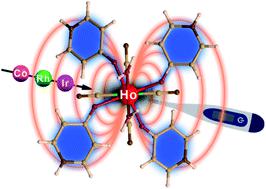当前位置:
X-MOL 学术
›
Chem. Sci.
›
论文详情
Our official English website, www.x-mol.net, welcomes your feedback! (Note: you will need to create a separate account there.)
Holmium(III) molecular nanomagnets for optical thermometry exploring the luminescence re-absorption effect
Chemical Science ( IF 8.4 ) Pub Date : 2020-10-30 , DOI: 10.1039/d0sc04871b Junhao Wang 1 , Jakub J Zakrzewski 2 , Mikolaj Zychowicz 2, 3 , Veacheslav Vieru 3, 4 , Liviu F Chibotaru 3 , Koji Nakabayashi 1 , Szymon Chorazy 2 , Shin-Ichi Ohkoshi 1
Chemical Science ( IF 8.4 ) Pub Date : 2020-10-30 , DOI: 10.1039/d0sc04871b Junhao Wang 1 , Jakub J Zakrzewski 2 , Mikolaj Zychowicz 2, 3 , Veacheslav Vieru 3, 4 , Liviu F Chibotaru 3 , Koji Nakabayashi 1 , Szymon Chorazy 2 , Shin-Ichi Ohkoshi 1
Affiliation

|
Coordination complexes of lanthanide(3+) ions can combine Single-Molecule Magnetism (SMM) with thermally modulated luminescence applicable in optical thermometry. We report an innovative approach towards high performance SMM-based optical thermometers which explores tunable anisotropy and the luminescence re-absorption effect of HoIII complexes. Our concept is shown in dinuclear cyanido-bridged molecules, {[HoIII(4-pyridone)4(H2O)2][MIII(CN)6]}·nH2O (M = Co, 1; Rh, 2; Ir, 3) and their magnetically diluted analogues, {[HoIIIxYIII1–x(4-pyridone)4(H2O)2][MIII(CN)6]}·nH2O (M = Co, x = 0.11, 1@Y; Rh, x = 0.12, 2@Y; Ir, x = 0.10, 3@Y). They are built of pentagonal bipyramidal HoIII complexes revealing the zero-dc-field SMM effect. Experimental studies and the ab initio calculations indicate an Orbach magnetic relaxation with energy barriers varying from 89.8 to 86.7 and 78.7 cm−1 K for 1, 2, and 3, respectively. 1–3 also differ in the strength of quantum tunnelling of magnetization which is suppressed by hyperfine interactions, and, further, by the magnetic dilution. The YIII-based dilution governs the optical properties as 1–3 exhibit poor emission due to the dominant re-absorption from HoIII while 1@Y–3@Y show room-temperature blue emission of 4-pyridone. Within ligand emission bands, the sharp re-absorption lines of the HoIII electronic transitions were observed. Their strong thermal variation was used in achieving highly sensitive ratiometric optical thermometers whose good performance ranges, lying between 25 and 205 K, are adjustable by using hexacyanidometallates. This work shows that HoIII complexes are great prerequisites for advanced opto-magnetic systems linking slow magnetic relaxation with unique optical thermometry exploiting a luminescence re-absorption phenomenon.
中文翻译:

用于光学测温的钬 (III) 分子纳米磁体探索发光重吸收效应
镧系元素 (3+) 离子的配位配合物可以将单分子磁性 (SMM) 与适用于光学测温的热调制发光相结合。我们报告了一种针对高性能基于 SMM 的光学温度计的创新方法,该方法探索了可调谐的各向异性和 Ho III配合物的发光重吸收效应。我们的概念体现在双核氰基桥接分子中,{[Ho III (4-pyridone) 4 (H 2 O) 2 ][M III (CN) 6 ]}· n H 2 O (M = Co, 1 ; Rh , 2 ; Ir, 3 ) 及其磁性稀释的类似物 {[HoIII x Y III 1– x (4-吡啶酮) 4 (H 2 O) 2 ][M III (CN) 6 ]}· n H 2 O (M = Co, x = 0.11, 1@Y ; Rh, x = 0.12, 2@Y ; Ir, x = 0.10, 3@Y )。它们由五角形双锥 Ho III配合物构成,揭示了零直流场 SMM 效应。实验研究和从头算计算表明,Orbach 磁弛豫具有从 89.8 到 86.7 和 78.7 cm -1不等的能垒K 分别代表1、2和3。图1-3的磁化量子隧穿强度也不同,这种强度受到超精细相互作用的抑制,此外,还受到磁稀释的抑制。基于 Y III的稀释控制光学性质,因为1-3由于来自 Ho III的主要重吸收而表现出较差的发射,而1@Y-3@Y表现出 4-吡啶酮的室温蓝色发射。在配体发射带内,Ho III的尖锐重吸收线观察到电子跃迁。它们强烈的热变化被用于实现高灵敏度比率光学温度计,其良好的性能范围在 25 和 205 K 之间,可通过使用六氰基金属酸盐进行调节。这项工作表明,Ho III配合物是将慢磁弛豫与利用发光重吸收现象的独特光学测温法联系起来的先进光磁系统的重要先决条件。
更新日期:2020-11-16
中文翻译:

用于光学测温的钬 (III) 分子纳米磁体探索发光重吸收效应
镧系元素 (3+) 离子的配位配合物可以将单分子磁性 (SMM) 与适用于光学测温的热调制发光相结合。我们报告了一种针对高性能基于 SMM 的光学温度计的创新方法,该方法探索了可调谐的各向异性和 Ho III配合物的发光重吸收效应。我们的概念体现在双核氰基桥接分子中,{[Ho III (4-pyridone) 4 (H 2 O) 2 ][M III (CN) 6 ]}· n H 2 O (M = Co, 1 ; Rh , 2 ; Ir, 3 ) 及其磁性稀释的类似物 {[HoIII x Y III 1– x (4-吡啶酮) 4 (H 2 O) 2 ][M III (CN) 6 ]}· n H 2 O (M = Co, x = 0.11, 1@Y ; Rh, x = 0.12, 2@Y ; Ir, x = 0.10, 3@Y )。它们由五角形双锥 Ho III配合物构成,揭示了零直流场 SMM 效应。实验研究和从头算计算表明,Orbach 磁弛豫具有从 89.8 到 86.7 和 78.7 cm -1不等的能垒K 分别代表1、2和3。图1-3的磁化量子隧穿强度也不同,这种强度受到超精细相互作用的抑制,此外,还受到磁稀释的抑制。基于 Y III的稀释控制光学性质,因为1-3由于来自 Ho III的主要重吸收而表现出较差的发射,而1@Y-3@Y表现出 4-吡啶酮的室温蓝色发射。在配体发射带内,Ho III的尖锐重吸收线观察到电子跃迁。它们强烈的热变化被用于实现高灵敏度比率光学温度计,其良好的性能范围在 25 和 205 K 之间,可通过使用六氰基金属酸盐进行调节。这项工作表明,Ho III配合物是将慢磁弛豫与利用发光重吸收现象的独特光学测温法联系起来的先进光磁系统的重要先决条件。



























 京公网安备 11010802027423号
京公网安备 11010802027423号